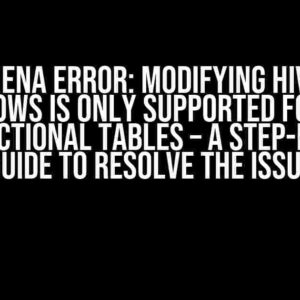Are you tired of dealing with cumbersome queries and endless scrolling through your DynamoDB table? Do you want to learn how to filter your queries with precision and efficiency? Look no further! In this comprehensive guide, we’ll dive into the world of DynamoDB pagination and explore how to filter a query of an array of strings with a limit. Buckle up, because we’re about to take your DynamoDB skills to the next level!
Understanding DynamoDB Pagination
Before we dive into filtering queries, it’s essential to grasp the concept of pagination in DynamoDB. Pagination is a technique used to divide a large dataset into smaller, more manageable chunks, making it easier to retrieve and process data. In DynamoDB, pagination is achieved using the Limit parameter, which specifies the maximum number of items to return in a single query.
Why Do I Need Pagination?
Without pagination, your queries would return an enormous amount of data, leading to performance issues and increased latency. By limiting the number of items returned, you can:
- Reduce the amount of data transferred between your application and DynamoDB
- Improve query performance and reduce latency
- Enhance overall system reliability and scalability
Filtering Queries with a Limit
Now that we’ve covered the basics of pagination, let’s move on to filtering queries with a limit. In this scenario, we’ll explore how to filter an array of strings using the FilterExpression parameter.
Step 1: Define Your Filter Expression
To filter an array of strings, you’ll need to define a filter expression that specifies the conditions for which items to include in the result set. In this example, we’ll use the contains function to search for a specific string within an array.
FilterExpression: "contains(figures, :figure)",
ExpressionAttributeValues: {
":figure": {
S: "Batman"
}
}
In this example, the filter expression searches for the string “Batman” within the figures array. The contains function returns true if the string is found, and false otherwise.
Step 2: Define Your Query Parameters
Next, define your query parameters, including the Limit parameter, which specifies the maximum number of items to return.
params = {
TableName: "my-table",
FilterExpression: "contains(figures, :figure)",
ExpressionAttributeValues: {
":figure": {
S: "Batman"
}
},
Limit: 10
};
In this example, we’re setting the Limit parameter to 10, which means our query will return a maximum of 10 items that match the filter expression.
Step 3: Execute Your Query
Finally, execute your query using the query method provided by the AWS SDK.
dynamodb.query(params, (err, data) => {
if (err) {
console.log(err);
} else {
console.log(data);
}
});
This will return a result set containing a maximum of 10 items that match the filter expression.
Advanced Filtering Techniques
Now that we’ve covered the basics of filtering queries with a limit, let’s explore some advanced techniques to take your skills to the next level.
Using Multiple Conditions with AND and OR Operators
What if you need to filter your query based on multiple conditions? You can use the AND and OR operators to combine multiple filter expressions.
FilterExpression: "contains(figures, :figure) AND size(figures) > :minSize",
ExpressionAttributeValues: {
":figure": {
S: "Batman"
},
":minSize": {
N: 5
}
}
In this example, the filter expression combines two conditions: the contains function searches for the string “Batman” within the figures array, and the size function checks if the array size is greater than 5.
Using IN Operator for Array Membership
What if you need to check if an array contains multiple values? You can use the IN operator to check for array membership.
FilterExpression: "figures IN (:figure1, :figure2)",
ExpressionAttributeValues: {
":figure1": {
S: "Batman"
},
":figure2": {
S: "Superman"
}
}
In this example, the filter expression checks if the figures array contains either “Batman” or “Superman”.
Common Pitfalls and Troubleshooting
Even with the best intentions, things can go wrong. Here are some common pitfalls to watch out for and troubleshooting tips:
| Pitfall | Troubleshooting Tip |
|---|---|
| Invalid filter expression | Check the filter expression syntax and ensure it’s correctly formatted. |
| Incorrect data type | Verify that the data type of the attribute matches the data type of the value in the filter expression. |
| Missing or incorrect attribute names | Double-check that the attribute names in the filter expression match the actual attribute names in the DynamoDB table. |
Conclusion
Mastering DynamoDB pagination and filtering queries with a limit requires practice, patience, and a deep understanding of the underlying mechanics. By following the steps outlined in this guide, you’ll be well on your way to crafting efficient and effective queries that return exactly what you need.
Remember, the key to success lies in:
- Defining a clear and concise filter expression
- Setting a reasonable limit to control the number of items returned
- Using advanced filtering techniques to refine your results
- Troubleshooting common pitfalls with ease
With these skills in your toolkit, you’ll be able to tackle even the most complex queries with confidence and precision. Happy querying!
Frequently Asked Question
If you’re struggling to filter a query of an array of strings with a limit in DynamoDB pagination, don’t worry, you’re not alone! Here are some frequently asked questions that might just save the day.
How do I filter a query of an array of strings in DynamoDB?
You can use the `contains` function in your query filter expression. For example, if you have an attribute called `colors` which is an array of strings, you can use the following filter expression: `contains(colors, :color)`. This will return all items that have the specified `:color` in the `colors` array.
How do I limit the number of items returned in a DynamoDB query?
You can use the `Limit` parameter in your query request. For example, if you want to return only the first 10 items, you can set `Limit` to 10. Note that DynamoDB will return the first 10 items that match the query filter expression.
Can I use pagination with a filtered query in DynamoDB?
Yes, you can use pagination with a filtered query in DynamoDB. To do this, you need to use the `ExclusiveStartKey` parameter in your query request. This parameter specifies the primary key of the last item returned in the previous query, and DynamoDB will return the next batch of items starting from that key.
How do I handle pagination with a large dataset in DynamoDB?
When dealing with large datasets, it’s essential to use pagination to avoid fetching too much data at once. You can use the `Limit` parameter to control the number of items returned in each query, and then use the `ExclusiveStartKey` parameter to fetch the next batch of items. Additionally, you can use parallel processing or caching to improve performance.
What is the maximum number of items I can return in a DynamoDB query?
The maximum number of items you can return in a DynamoDB query is 1MB. If your query returns more items than this, DynamoDB will return an error. To avoid this, use pagination to fetch items in batches, and adjust the `Limit` parameter accordingly.


